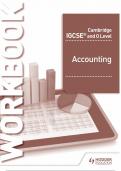Exam (elaborations)
Cambridge IGCSE and O Level Accounting Test Bank Workbook ISBN 9781510421226
- Course
- IGCSE and O Level Accounting
- Institution
- 123 University
There is no set way to approach using this Workbook. You may wish to use it to supplement your understanding of the different topics as you work through each chapter of the Student’s Book, or you may prefer to use it to reinforce your skills in dealing with particular topics as you prepare for...
[Show more]



